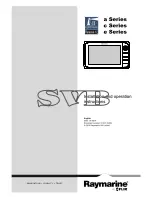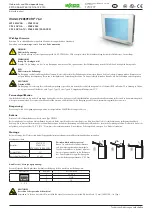
12
–
expansion tank and automatic valves to keep the system pressure and compensate for thermal expansion
–
check that the automatic glycol loading in the circuit is carried out with a mixture of the same concentration as that
already present. Otherwise you may risk the hydraulic circuit freezing with serious damage to the parts concerned.
–
a drain cock and if necessary a drain tank to empty the system for maintenance operations or seasonal breaks.
–
a by-pass on the water side secondary circuit: to ensure a minimum water flow on the secondary side (chilled
beams feeding); a by-pass branch must be provided for, even if all two-way valves of the chilled beams are closed,
to allow the passage of a minimum amount to guarantee the cooling of the pump. It is good practice that this
branch is equipped with a valve allowing its calibration.
–
it is strongly recommended to install a safety valve on the hydraulic circuit (if not provided on the chiller): in the
event of serious system anomalies (e.g. fire), it allows to drain the system avoiding possible outbreaks. Always
connect the drain to a pipe with a diameter that is no less than that of the valve opening, and convey it to areas
where the jet cannot cause harm to people.
On the hydraulic connection to the outside it is compulsory to install a wire mesh filter, with the
mesh size no larger than 1 mm, on the water inlet pipes. Failure to do so will immediately invalidate
the warranty.
Use a suitable percentage of antifreeze if the hydraulic circuit is at room temperature close to or
below zero Celsius.
It is a good rule to empty the hydraulic system in case of prolonged periods of inactivity.
To make it easier to drain the circuit there is a draining valve located on the bottom of the tank, when there is a tank, or at
the lowest point of the circuit when there is no tank. There is also a relief valve on the top of this tank, or at the highest point
of the circuit if there is no tank, designed to eliminate air bubbles from the circuit.
When the system is switched back on and the circuit is re-loaded, it must either be loaded with water or a mixture of water
and ethylene glycols, in the percentage stated on the plate.







































